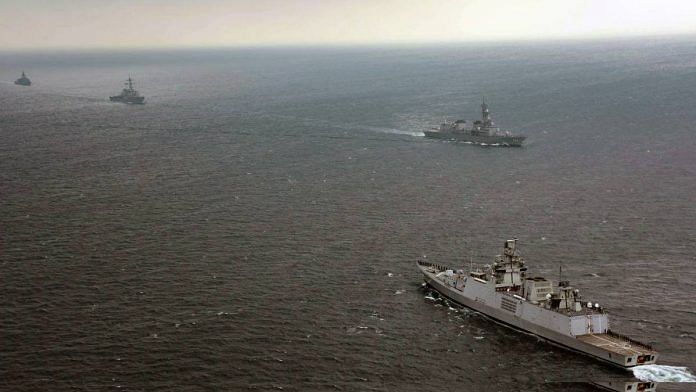New Delhi: The production of new nuclear-powered attack submarines to meet the United States Navy’s target of operating a fleet of between 66 and 72 may be completed only by 2052 under the navy’s plan, a new report by the official Congressional Research Service has said. The schedule could hurt Australia’s plans to acquire its own nuclear-powered submarines and retard regional efforts to counter China’s growing power in the Indian Ocean and the Pacific.
The report was released Wednesday.
Last year’s Australia-United Kingdom-United States partnership, or AUKUS, had led Canberra to scrap its plans to build twelve French-designed conventional submarines, and announce it would instead acquire nuclear-powered attack submarines.
The speed, stealth, and endurance of nuclear-powered attack submarines, or SSNs — limited by the crew’s need for supplies — mean they are considered among the most lethal elements of modern naval arsenals. In, 2019, India had signed an agreement with Russia to lease an SSN. It also plans to build six SSNs.
Australia is expected to announce its submarine acquisition plans early next year but defence minister Richard Marles said last week that hopes that nuclear-powered boats would become available by the end of the decade “would be extremely optimistic.”
Even though the Chinese People’s Liberation Army Navy (PLAN) is currently thought to have only a small number of SSNs, the strength of the fleet is expected to grow to 13 or more by 2030, the United States government believes.
Also Read: India’s submarine plans hit by dwindling fleet as Navy decommissions INS Sindhudhvaj
The concerns
The PLAN has invested in new submarine construction halls at the Bohai Shipyard at Huludao, which are reported to give it the capacity to simultaneously build five submarines.
There are only two shipbuilding yards — General Dynamics’ Electric Boat Division in Connecticut, and the Huntington-Ingalls Newport News Shipbuilding in Virginia — which are currently capable of producing nuclear-powered ships for the United States Navy. General Dynamics only produces submarines, while Huntington-Ingalls also manufactures nuclear-powered surface ships.
Experts, the CRS says, have voiced concerns about the “industrial base’s capacity for executing such a workload without encountering bottlenecks or other production problems”.
In the United Kingdom, production demands for the Astute-class SSN, which is replacing the ageing Trafalgar class, have already stretched the Barrow shipyard to capacity. Expanding production, experts say, will need investment, not just in production facilities but also for hard-to-find engineers and technology experts.
Former Australian naval commanders have been warning that the country may need need to acquire new conventional submarines to keep up with the PLAN’s growing fleet. The commanders, in an open letter, questioned if the existing fleet of Collins-class boats “still be safe to operate, let alone whether they should be used in a fight” before nuclear-powered replacements became available.
The United States’s thirty-year shipbuilding plan, the Congressional Research Service report says, calls for a nuclear attack submarine force that will reach a minimum of 46 boats by 2028, grow to 50 boats by 2032, and level out at 60 to 69 SSNs by 2052. The SSN growth plan is part of a larger commitment to build a fleet of 364 ships, some 150 of them unmanned platforms.
Large investments by China have seen the PLAN grow into the world’s largest navy, with over 355 ships. Earlier this week, the United States Navy warned of the “erosion of credible military deterrence, particularly due to China’s rapidly increasing military capabilities”.
The United States SSN fleet peaked in 1987, at 98 boats, but diminished steadily after that, along with the overall naval arsenal, as the Cold War threat diminished. The United States Navy currently has three types of SSNs in its fleet: 28 of the Los Angeles class, 19 of the Virginia class, and 3 of the Seawolf class. It also has four larger Ohio class general-purpose nuclear submarines, capable of similar missions.
Fears had been voiced that the United States SSN fleet would shrink to just 42 boats by 2027-2028, but the gap has been filled by extending the lifespan of existing Los Angeles class platforms.
Also read: NATO wants to push back against China, but members’ military spending still lags behind






